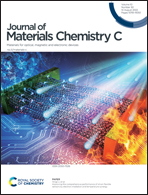A magnetic field-switchable millimeter wave switch for 81, 94, and 140 GHz based on metal substituted ε-iron oxide†
Abstract
Millimeter waves have recently spread to wireless communication and imaging fields. In particular, millimeter waves at 81, 94, and 140 GHz are essential from the viewpoint of practical applications. Herein we report an external magnetic field effect on the millimeter wave absorption of ε-GaxFe2−xO3 nanomagnets with x = 0.46 (1), 0.29 (2), and 0.19 (3) and ε-AlxFe2−xO3 nanomagnets with x = 0.47 (4), 0.23 (5), and 0.16 (6). Terahertz time-domain spectroscopy (THz-TDS) measurements show that these materials display a zero-field ferromagnetic resonance in the millimeter wave range of 76–144 GHz. The ferromagnetic resonance was measured by applying an external magnetic field (Hex) to the sample along the remnant magnetization parallelly or antiparallelly. Switching the Hex value between +3.5 kOe and −3.5 kOe shifts the resonance frequency by 8–12 GHz (e.g., 70 ↔ 81 GHz (1), 94 ↔ 106 GHz (4), and 139 ↔ 147 GHz (6)). For example, a millimeter wave switch effect on the absorption intensity appears by changing the Hex value due to the magnetic field–induced resonance frequency shift, i.e., from 2 to 11 dB at 81 GHz for 1. Theoretical calculations of the ferromagnetic resonance based on Landau–Lifshitz–Gilbert theory reproduce the magnetic field–induced switching.



 Please wait while we load your content...
Please wait while we load your content...